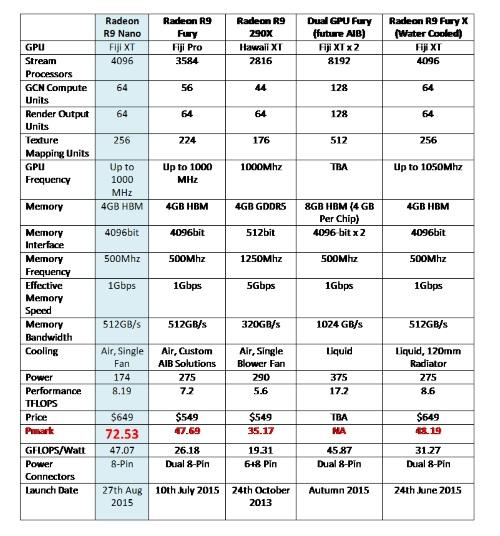digitalwanderer
Legend
That is the big question right now.Whether it makes sense for a consumer is something else...
Think it'd fit in a really, really decent sized laptop?
Follow along with the video below to see how to install our site as a web app on your home screen.
Note: This feature may not be available in some browsers.
That is the big question right now.Whether it makes sense for a consumer is something else...
Cute.What? Where did you see that?
The idea seems to be that they're offering something unique, in that the Nano performs at a level that is unmatched by any card of this size, which has value for people who want compact systems.
That may be true, but in practice I'm skeptical that it will convince a significant number of buyers.
But unique for how long? If it does gain a market, there are presumably no major barriers to the production of a Geforce GTX 980 "mITX" which can significantly undercut it on price while coming very close in performance.
Cute.
First: my sentence starts with 'if'. It's a speculation.
Second: you know very well my opinion on Fiji products having much lower margins than gm200 due to their usage of HBM.
Why? The Asus & Gigabyte GTX 970 "mITX" are only an inch longer (or taller depending on how you count the PCI-E connector), and their decent overclocking results suggest the power circuitry could handle a fully unlocked GM204 with reduced overclocking potential.But quite likely nowhere even remotely close to its size.
Regards,
SB
Why? The Asus & Gigabyte GTX 970 "mITX" are only an inch longer, and their decent overclocking results suggest the power circuitry could handle a fully unlocked GM200 with reduced overclocking potential.
Looking how the core clock should be extremely constrained on the Nano, just push the power limit slider on the CCC and you should easely goes to +15% performance.
AMD specifically said in the briefing, that given good cooling and a well ventilated case, you could push the Nano all the way up to Fury X power levels.I doubt the VRMs are capable of handling a 15% overclock, not to mention the cooling system and air exhaustion capabilities of the tiny mITX case models that require the Nano.
Erm.. then I guess you might as well just buy the Fury X, because the price is the same, the adequate cooling system is already there and you have some overclocking headroom on top of Fury X's levels.AMD specifically said in the briefing, that given good cooling and a well ventilated case, you could push the Nano all the way up to Fury X power levels.
I doubt the VRMs are capable of handling a 15% overclock, not to mention the cooling system and air exhaustion capabilities of the tiny mITX case models that require the Nano.
But it's no where near as cute and tiny! :OErm.. then I guess you might as well just buy the Fury X, because the price is the same, the adequate cooling system is already there and you have some overclocking headroom on top of Fury X's levels.
Forum strength is for others to judge. I'm basing it more on 25 years in the semiconductor business, and the experience that complex things with high added value with only a single supplier never come cheap, especially not in low volume. And you're absolutely right: it's all because of HBM. How could it not be? The die sizes are identical.Yes, you've been spending all you forum-strength to convince everyone that the Fury X is much more expensive to make than the GM200 cards, because HBM.
But you had never reached the point of ludicrousness to suggest the $650 Fury X is aggressively priced.
Not at all. I have stated a couple of times, directly or indirectly, that the gross margins of Fiji must still be very positive.What's next? AMD loses money with each Fury X sold, because HBM?
C'mon guys, let's not fight over "forum strength"! Let's remember it's all about the post count, now WORSHIP ME!!!Forum strength is for others to judge.
http://www.eetimes.com/author.asp?section_id=36&doc_id=1327544&With 30 percent more performance and 30 percent lower power than the previous generation Radeon R9 290X AIB, the 175W Radeon R9 Nano becomes the world’s most power efficient Mini ITX enthusiast graphics card available—period. This sets a new bar on size and performance. Its price is going to challenge a few users, but in graphics you really do get what you pay for, so we think this is a good deal if you can afford it.
Cooling is not the only part of the equation; the new Nano gets the best performance per watt and price—check the Pmark scores. (The Pmark is JPR’s comparison of price, wattage, and performance to calculate a products comparative value.)
The AIB’s GPU has 256 texture mapping units and 64 raster operation units. Compared to the Radeon R9 Fury X with 8.6 TFlops and a 1050 MHz GPU clock, the Radeon R9 Nano hits 8.19 TFlops with a 1000 MHz engine clock. It accomplishes that partially by employing greater memory bandwidth over GDDR5 via a 4096-bit memory interface. Normally a wide bus width will cost you in power consumption, but AMD came up with some clever low power switches which they are not talking about.

I've seen Q1 2016 mentioned for GP100 but who knows if that's realistic.You're probably right, but it might still be a year away, perhaps even further out. It could also happen sooner, of course, but as far as I'm aware, no information has been made public, and nothing particularly credible has leaked.
